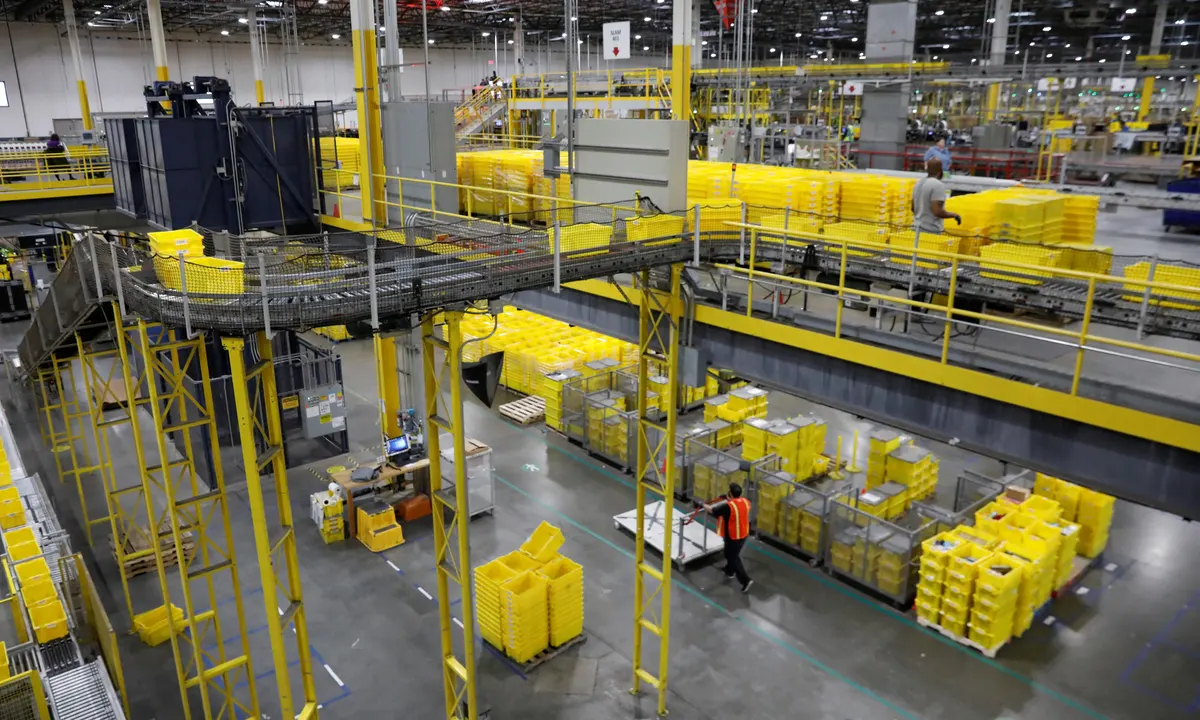Introduction to Amazon Warehouse DMI3
Welcome to the intriguing world of Amazon Warehouse DMI3, where secrets abound and innovation thrives! Behind those seemingly ordinary doors lies a bustling hub of activity that powers one of the world’s largest e-commerce empires. In this blog post, we will peel back the layers and delve into the fascinating mysteries surrounding DMI3, uncovering its history, operations, controversies, and plans for the future.
Are you ready to embark on an adventure through this enigmatic warehouse facility? Join us as we unlock the vaults of information and reveal some hidden gems along the way. Whether you’re a curious consumer or simply fascinated by behind-the-scenes logistics, this exploration promises to be an eye-opening journey like no other.
History of Amazon Warehouses
The history of Amazon warehouses is a fascinating journey into the evolution of one of the world’s largest e-commerce giants. It all began in 1994 when Jeff Bezos founded Amazon as an online bookstore in his garage. As the company grew rapidly, so did its need for storage and fulfillment centers.
In the early days, Amazon relied on third-party logistics providers to handle its warehousing operations. However, as demand skyrocketed and customer expectations increased, it became clear that having control over every aspect of the supply chain was crucial to deliver excellent service.
To meet this growing demand, Amazon started building its own network of fulfillment centers across the United States and eventually expanded globally. These massive warehouses were strategically located near major cities to ensure fast and efficient delivery to customers.
Over time, these warehouses evolved from simple storage facilities into highly automated hubs powered by advanced technologies like robotics and artificial intelligence. This transformation allowed Amazon to process orders at lightning speed while minimizing human error.
Today, Amazon operates hundreds of warehouses worldwide, with each facility tailored to meet specific regional needs. From small sorting centers to large-scale fulfillment centers spanning millions of square feet, these warehouses form a critical part of Amazon’s global infrastructure.
The history of Amazon’s warehouse expansion has not been without controversies. Reports have highlighted concerns about working conditions in some facilities, including long hours and high pressure for productivity. The company has made efforts to address these issues by improving safety measures and increasing wages for employees.
Location and Size of DMI3
When it comes to the secrets of Amazon Warehouse DMI3, one important aspect to explore is its location and size. Situated in an undisclosed location, DMI3 stands as a massive testament to Amazon’s logistical prowess.
Covering an expansive area that spans hundreds of thousands of square feet, DMI3 operates as a hub for receiving, storing, and shipping countless packages each day. The sheer scale of this facility is awe-inspiring, with rows upon rows of towering shelves housing products ready for distribution.
The strategic placement of DMI3 allows for efficient transportation routes to major cities across the region. This ensures faster delivery times and more streamlined operations overall. However, due to security reasons and competitive advantages, the exact whereabouts remain shrouded in secrecy.
The immense size also means that there are countless job opportunities available within DMI3. From warehouse associates handling inventory management to logistics coordinators orchestrating shipments, employees play a crucial role in keeping this behemoth running smoothly.
Despite concerns over working conditions at some Amazon warehouses in the past, efforts have been made to improve employee experiences at locations like DMI3. Competitive wages and benefits packages aim to attract top talent while creating an environment conducive to success.
As we delve deeper into exploring the secrets behind Amazon Warehouse DMI3, it becomes clear that its location plays a vital role in its success. In future plans for expansion or new facilities like DMI4 or beyond (if they exist!), it will be interesting to see how these aspects evolve and impact local communities on both economic and social levels
Inside DMI3: A Closer Look at Operations and Technology
Step inside the doors of Amazon’s DMI3 warehouse, and you’ll be greeted by a bustling hive of activity. This massive facility spans over 1 million square feet, housing countless shelves stacked high with products waiting to be shipped to customers around the world.
The operations at DMI3 are a well-oiled machine, with an intricate system in place to ensure smooth workflows. State-of-the-art technology plays a crucial role here, from automated conveyor belts that transport goods efficiently across the warehouse floor to robotic arms that assist in picking and packing items for shipping.
Every item within DMI3 is meticulously tracked using advanced inventory management systems. This allows for real-time monitoring of stock levels, ensuring that popular items never run out of stock while minimizing waste on less popular ones.
To keep up with the fast-paced demands of e-commerce, Amazon relies heavily on data analytics and artificial intelligence (AI). These tools help optimize processes such as order fulfillment and inventory forecasting, allowing for greater efficiency and customer satisfaction.
Not only does DMI3 prioritize operational excellence through its use of cutting-edge technology but it also places a strong emphasis on employee well-being. The company offers competitive wages along with comprehensive benefits packages. Safety protocols are strictly enforced to create a secure working environment for all employees.
Working at DMI3: Employee Experience and Benefits
At Amazon’s DMI3 warehouse, employees are at the heart of its operations. The company prides itself on providing a positive work environment that fosters growth and development for its workforce.
One of the key benefits of working at DMI3 is the competitive salary and comprehensive benefits package offered to employees. From healthcare coverage to retirement plans, Amazon ensures that its workers are well taken care of both during their time with the company and beyond.
In addition to financial security, DMI3 offers various opportunities for career advancement. With a wide range of job roles available within the warehouse, employees have the chance to explore different areas and build their skills. Training programs are also provided to help individuals enhance their knowledge and gain new qualifications.
Another aspect that sets working at DMI3 apart is the focus on employee safety. Amazon prioritizes creating a safe work environment through regular safety training sessions, ergonomic workstations, and strict adherence to health protocols.
Furthermore, teamwork plays a crucial role in fostering an inclusive culture at DMI3. Employees collaborate closely with each other as they navigate through daily tasks efficiently while maintaining high productivity standards.
Controversies Surrounding Amazon Warehouses
Amazon, the retail giant that has revolutionized the way we shop, is not without its fair share of controversies. One of the most significant areas where controversy arises is in relation to its warehouses. As Amazon’s operations continue to expand and its dominance in e-commerce grows, concerns have been raised about working conditions and employee treatment within these massive fulfillment centers.
Critics argue that the demanding work environment at Amazon warehouses can lead to physical strain on employees. Reports have surfaced of long hours, intense productivity targets, and inadequate break times. Furthermore, allegations of insufficient safety measures and lack of proper training have also been leveled against the company.
Another point of contention revolves around worker surveillance. Some claim that Amazon closely monitors its employees through sophisticated tracking systems and even penalizes them for taking breaks or engaging in activities deemed non-productive.
Moreover, issues related to job security and contract employment arrangements have been raised. Critics argue that a high turnover rate among warehouse workers perpetuates a cycle of temporary employment with limited benefits and little opportunity for career advancement.
Additionally, concerns regarding discrimination within Amazon warehouses have emerged. Accusations range from biased hiring practices to unfair treatment based on race or gender.
Future Plans for DMI3 and the Impact on Local Communities
As Amazon continues to expand its operations, the future plans for DMI3 are no exception. With a focus on efficiency and customer satisfaction, Amazon is constantly looking for ways to improve its warehouses. This includes implementing advanced technologies such as robotics and automation to streamline processes.
The impact of these future plans on local communities can be significant. On one hand, the expansion of DMI3 creates job opportunities for individuals in the area, boosting employment rates and stimulating economic growth. The presence of a major warehouse like DMI3 also attracts other businesses that may benefit from its proximity.
However, there are concerns about the working conditions within these warehouses. Reports have highlighted issues such as long hours, high productivity expectations, and limited breaks for employees. It is important that Amazon addresses these concerns and ensures that workers are treated fairly.
Additionally, there may be environmental implications associated with the expansion of DMI3. Increased traffic from delivery trucks and emissions from warehouse operations could contribute to pollution levels in surrounding areas.
To mitigate these potential negative impacts, it is crucial for Amazon to engage with local communities and address any concerns they may have. This could involve investing in sustainable practices or collaborating with community organizations to support local initiatives.
Conclusion
As we’ve delved into the secrets of Amazon Warehouse DMI3, it’s clear that this sprawling facility plays a crucial role in Amazon’s vast logistical network. From its humble beginnings to its current status as one of the largest warehouses in the world, DMI3 has been at the forefront of revolutionizing e-commerce and fulfillment.
With cutting-edge technology and streamlined operations, DMI3 operates like a well-oiled machine, ensuring efficient order processing and speedy delivery for millions of customers worldwide. However, it is not without controversy. The demands placed on employees have raised concerns about working conditions and labor practices.
Despite these controversies, there is no denying the impact that Amazon Warehouses like DMI3 have on local communities. They provide employment opportunities and contribute to economic growth in their respective regions.










